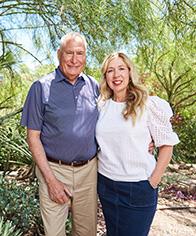Fellowships Make a Multidimensional Impact
Gary W. Pace PhD ’75 and Jinny Hamilton Pace

As a graduate student bartender at the Muddy Charles Pub, Gary Pace witnessed casual conversations between MIT community members—and the occasional astronaut—that sometimes led to real-world collaboration and innovation. “It was a meeting place for MIT students and faculty across disciplines who might never have interacted in another environment,” he recalls. Beyond apocryphal stories of revolutionary medical advances being conjured up over beers, Pace recalls how one patron helped him call home to Australia using an electronic device he made in the basement of Walker Memorial, a big help for a graduate student in the 1970s.
Pace has seen similarly serendipitous intersections between scientific innovation, resourcefulness, and entrepreneurship in his career as a founder and investor in the life sciences industry. Now, he and his spouse, Jinny, are paving the way for new generations of biological engineers through a fellowship for graduate students.
Graduate student success.
The fellowship will be funded through a charitable remainder unitrust (CRUT), which provides income to the donor and/or other beneficiaries while they are living and then goes to a designated cause at MIT. A gift that generates income for the family in the present while simultaneously pledging to support fellowships was a good choice for Gary and Jinny, who have three children at home. “I think the CRUT is a great vehicle that is a win-win for all,” Pace says. “MIT was a turning point for me, and the fellowship is truly about giving the same opportunity to graduate students starting their journey.”
“The CRUT is a great vehicle that is a win-win for all.”
Academic connections.
Pace was the first in his family to graduate from high school and college. “I was fortunate to win a Fulbright Scholarship and a research assistantship to Course 20,” Pace says. “That allowed me to continue what I’d been doing in food and fermentation technology. But at MIT, I was introduced to how engineering and applied biology could be applied to the pharmaceutical industry, agriculture, and life science industries.” A key difference was the entrepreneurial framing of the research. “I think I’ve always been naturally entrepreneurial, but to see students develop their ideas at MIT, to be in essence nurtured to go into industry and form companies, was a revelation,” he says. This meeting of academia and industry ultimately laid the path for his career. “I have always maintained close connections with the academic world because knowledge is fundamental to societal growth,” he says.
Multiple perspectives.
Pace sees the problem-solving skills he learned at MIT as essential to his life’s trajectory. After years of working in life sciences, often with startups that are developing novel products with nascent technologies, he’s familiar with what makes a successful company and how thinking creatively from multiple perspectives can make a new product or technology take off and have a positive impact. He and Jinny hope that their fellowship will support more of these dynamic thinkers at MIT who will go out and make a difference in the world. “When engineering and biological principles intersect,” Pace says, “you’re in a very powerful position to be able to identify and solve problems in a multidimensional way.”
